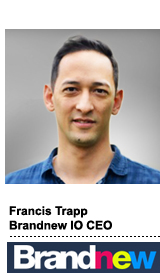 Everyone wants to get into native advertising, yet everyone has a different definition as to what exactly that entails. Social media sites have it easy because any sponsored post, automatically blending into the site design, can hitch a ride on the native bandwagon.
Everyone wants to get into native advertising, yet everyone has a different definition as to what exactly that entails. Social media sites have it easy because any sponsored post, automatically blending into the site design, can hitch a ride on the native bandwagon.
But while Facebook and Twitter are the current hotbeds of social advertising, Instagram and Pinterest are coming up fast. But unlike Facebook and Twitter, advertising around the two image-based interfaces revolves heavily around influencers, instead of traditional paid placements.
Berlin-based Brandnew IO, which began in early 2013, provides a platform and service designed to help brands reach influencers on Instagram and Pinterest.
“At that time we saw that more and more brands and agencies wanted to reach new consumers,” ssaid Brandnew CEO Francis Trapp. “They wanted to target groups on platforms like Instagram and at the time there was no central way of doing it.”
At first, Brandnew identified influencers manually but it soon developed a platform designed to automate the process and handles campaign tracking. That being said, Brandnew’s staff still needs to vet the influencers for quality.
“We check to ensure these influential people are worth taking onboard,” Trapp said. “We determine if they have big enough accounts and real followers as opposed to fake followers. We ensure that the quality of their content is suitable for our brands.”
Trapp spoke with AdExchanger.
AdExchanger: Brandnew pushes brand-produced images out for influencers to share. Is that actually native advertising?
FRANCIS TRAPP: We see ourselves as a company that connects brands with influential people. Obviously we also need to consult brands on what works for them on these social channels. Sometimes our clients have a very clear idea of what the campaign should look like, but sometimes they have no idea.
One thing we have to ensure is that the campaigns we run are interesting for all parties involved. On one hand this means that the client should run a campaign with an image that really represents their brand. On the other hand, the influencer should make sure that image is distributed to the right accounts. Our influencers always tell us that they want to run campaigns that don’t annoy their followers. That’s the main hurdle to native advertising.
Sometimes we see that certain clients of ours view Instagram, Facebook and Pinterest as social media and nothing more. We are convinced that each platform has a unique DNA, and the way people use each one differs. Typical demographics of Pinterest users differ from Instagram users. This has to be reflected in the campaigns we launch for the brands we represent.
Is native advertising going to become more addressable? Will it become more programmatic?
When we began we always took a manual approach, but our goal was always to build a company that was highly scalable. Native advertising is great, but it’s also very time-consuming and there’s a lot of effort involved. We try to offer a service that allows our clients to tap into our huge network and run multiple campaigns in a short period of time.
Who are some of your biggest clients?
Some of the brands we work with are Lufthansa, Mercedes Benz, Coca-Cola and L’Oréal. We offer different campaign types for our clients. One way is where the brand or agency gives us ready-made pictures or media, which we seed on Instagram or Pinterest. Another way is that brands provide pictures of the product itself for a product placement campaign. We also do photo contest campaigns, where our influences trigger contests so that their followers and other Instagram users will participate. The fourth campaign is storytelling. Storytelling means we launch a complex concept campaign that is just run by a few influences, and they tell the story over a longer period of time. Brands from different industries don’t tend to stick one campaign type.
What’s a use case example with a typical client you work with?
Once we’ve signed with a client, we categorize what kind of campaign type we’ll run (photo seeding, product placement, etc.). We then define the targeting of the campaign. For instance, we’ll outline if we’ll target people in certain countries, specific regions or globally. We can also target by interest groups and within verticals. Say we’re targeting in fashion. Within fashion we can target females, and specify our reach to “female street style.”
For example, Adidas launched a new soccer shoe. They gave us picture material which we then seeded on Instagram with various suitable influences that had accounts relating to soccer, sports shoes, etc.
Once we’ve programmed a campaign, our system runs targeted campaigns automatically. The system contacts the suitable people in our network, who can decide if they want to participate or not. Our system also does all the campaign tracking. We track which influencer posted what content at what time, what the reach involved was and also the number of likes or comments.
Are increased likes and followers, as campaign metrics, enough?
Increased followers is a very strong metric in these kinds of campaigns. We’ve seen that one single campaign post can result in 100 to 500 new followers for the brand. This can be seen on a continuous basis throughout the campaign progression. We’re also looking to develop more performance-based campaign results, for instance tracking the path to purchase for direct sales.
What’s Brandnew’s reach?
We saw that our network was, from the very first day, international. Right now we have almost 900 (influencers) in our network and their total audience is more than 190 million people. Our influencers are spread across the world, and majority of their audiences are in North America and western Europe. But we also have reach in South America, Asia Pacific and eastern Europe. We don’t focus on one country or region, we run campaigns across the map.
What can you say about revenue or growth?
We see that revenue range we’re generating is somewhere in the five to six euro-digit range each month, and it’s growing strongly.
Who are your competitors?
When we started a year ago, we chose Instagram as our platform simply because there weren’t many competitors back then. We now see that there are more competitors coming up. In Europe, we were the first but now there’s a second company doing what we do. In the US there are several companies running similar Instagram campaign services. Very often they have more of an agency approach.
You’re not an agency?
We’re not a creative agency; we position ourselves as a platform. We always say that our key strength at Brandnew is our strong international network. Our second defining factor is our technical platform that allows us to do all our campaign tracking and results automatically.
What’s next for Brandnew?
Our goal for Brandnew is to become the number one native advertising platform for various communities, not only for Instagram and Pinterest but also for any others that emerge in the future. We aim to do this on a global scale. We originally excluded Facebook from our offerings, because Facebook already had their central ad-booking system. Right now we’re looking into which platforms to add next and we expect to expand in that direction soon.











